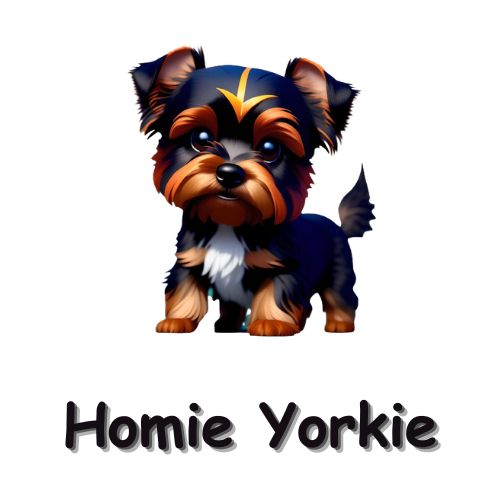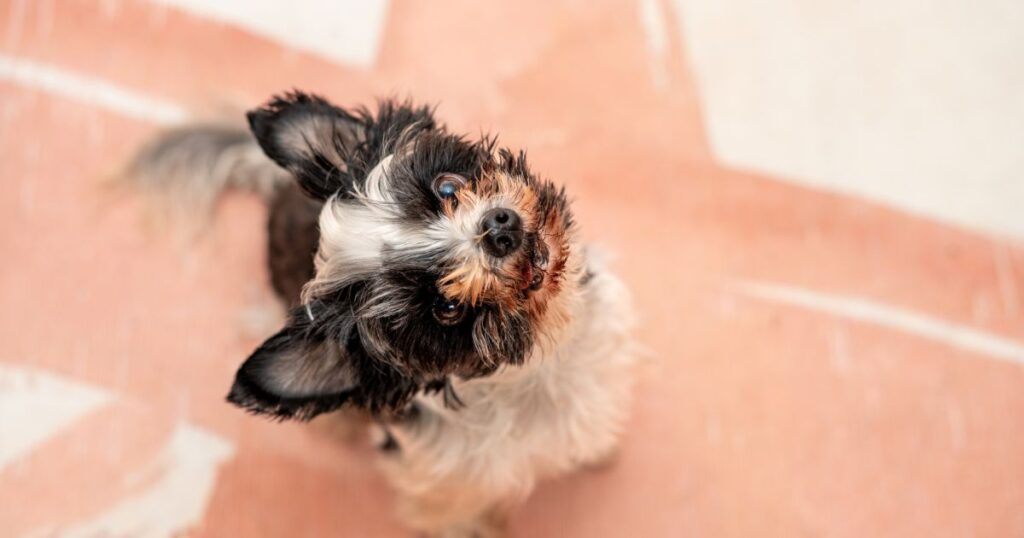Do Yorkies Have Tails? [Knowing Natural And Docked Tail]

Renowned for Yorkies’ charming personalities and luxurious coats, they possess another distinctive feature – their tails.
Yorkie tails are a defining characteristic of this breed and play a significant role in their overall appearance and expression. These adorable little tails, usually covered in long, flowing fur, add to the charm and elegance of the Yorkshire Terrier. They serve as a communication tool, as these dogs use their tails to express emotions like happiness, excitement, and even curiosity.
Tail docking, a practice often associated with certain dog breeds, including Yorkies, has been a subject of both interest and controversy. Tail docking involves the removal of a portion of a puppy’s tail shortly after birth. Tail docking is mainly done when the Yorkies are very young, typically between 2-5 days old.
The practice has a long history and various reasons behind it. However, it has sparked ethical debates and led to different regulations across the globe.
In this article, we will delve into the intriguing world of Yorkie tails, exploring everything from their natural length to the practice of tail docking and the concept of responsible ownership.
Do Yorkies Have Tails From Birth?
Yes, Yorkshire Terriers do have tails. However, it’s important to note that many Yorkies have their tails docked, which means their tails are surgically shortened in accordance with the AKC official breed standard conformation.
Yorkie Tails and Tail Docking
When it comes to Yorkies and their tails, there’s more than meets the eye. Let’s delve into the historical perspective, reasons behind tail docking, the ethical debates surrounding the practice, and the global regulations in place.
A. The Historical Perspective
Yorkshire Terrier tail docking has a long and interesting history. It is believed that tail docking originally began for practical reasons. Back when Yorkies were first developed in the 19th century, they were primarily used as rat catchers in mines and textile mills in England.
Their tails, which were left long, often got caught in machinery or dirt, leading to injuries and infections. To prevent such accidents and to improve the working ability of these dogs, tail docking was introduced as a protective measure.
As the Yorkshire Terrier breed gained popularity beyond its working origins and entered the world of dog shows and companion pets, tail docking remained prevalent. The aesthetics of a docked tail became associated with the breed standard and conformation, which ultimately solidified the practice within the Yorkshire Terrier community.
B. Reasons for Tail Docking
Over time, as Yorkies transitioned from working dogs to beloved companions, the reasons for tail docking evolved. One of the main reasons was rooted in breed standards and conformation.
Many kennel clubs and breed registries, such as the American Kennel Club (AKC), traditionally required Yorkies to have docked tails to conform to the breed’s aesthetic appearance in dog shows.
The practice of tail docking also found its way into popular culture, as many people came to associate the appearance of Yorkies with docked tails. This led to a demand for Yorkies with docked tails, sustaining the practice in some circles.
Some breeders and owners continue to dock tails, believing it prevents potential tail injuries, especially in smaller Yorkies who might be more prone to accidents.
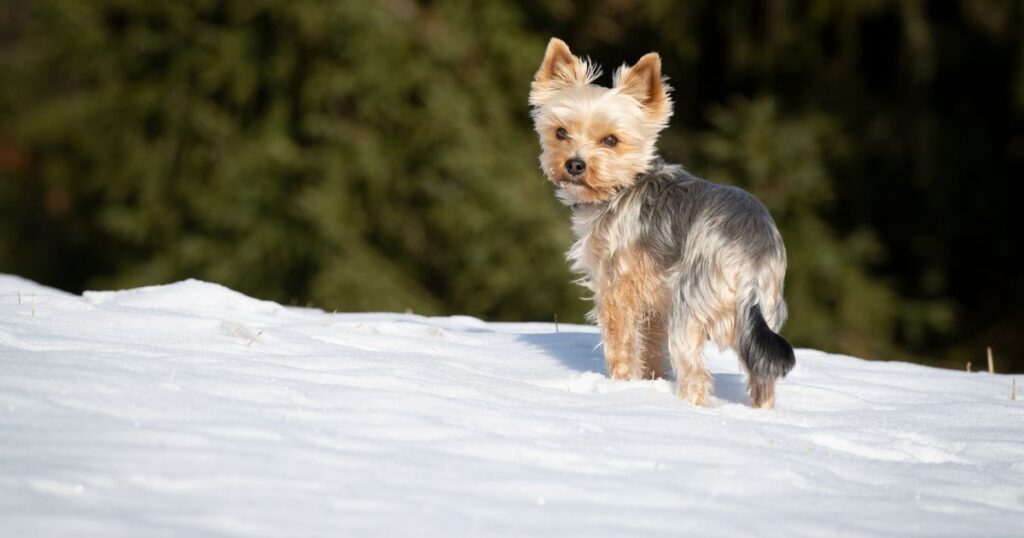
C. Ethical Debates on Tail Docking
As attitudes towards animal welfare and ethical considerations evolved, so did the debates surrounding tail docking. Critics argue that docking a dog’s tail is a painful procedure, and it impairs the animal’s natural state and ability to communicate through tail movements.
They support leaving the tails of Yorkies and other breeds intact, promoting the expression of their emotions and enhancing their overall well-being.
With the decrease in the need for working Yorkies, opponents argue that there is no substantial medical justification for tail docking in the modern context.
On the other hand, some proponents of tail docking contend that when done at a very young age, the procedure is relatively less painful, and the dogs recover quickly.
They maintain that tail docking remains essential for certain working breeds to prevent tail injuries during their active duties. Some critics argue that docking a puppy’s tail is a painful procedure that can cause distress and discomfort, affecting their overall well-being.
As civil values regarding animal welfare evolve, the ethical implications of tail docking come under inspection, with many countries imposing restrictions or outright bans on the practice.
D. Global Regulations on Tail Docking
The practice of tail docking is subject to various regulations and laws worldwide, with different countries adopting distinct views. Some countries have imposed outright bans on tail docking for non-medical reasons, considering it an unnecessary and harmful procedure.
In contrast, others allow tail docking but only under specific conditions, such as having it performed by licensed veterinarians and only for certain working breeds.
The regulations may also differ for show dogs and pet dogs, with some dog show standards still requiring docked tails for certain breeds like Yorkies.
Refer below to understand the regulations of tail docking in different countries.
- United States: The American Veterinary Medical Association (AVMA) opposes tail docking for cosmetic purposes. However the practice is still permitted for certain working breeds, including Yorkies, provided it is done by a licensed veterinarian.
- United Kingdom: The UK enacted a ban on tail docking in 2007, prohibiting the practice except for specific working dog breeds and only when carried out by a qualified veterinarian.
- Australia: Tail docking is generally prohibited across the country, except for working dogs and specific breed standards.
- Canada: Canada allows tail docking for certain working breeds, but it is banned for cosmetic purposes in some provinces.
- European Union: The EU has taken a unified stance against tail docking for non-medical reasons, and it is illegal in many member states.
As responsible pet owners, it’s essential to familiarize ourselves with the regulations in our respective regions to make informed decisions about tail docking for our Yorkies.
Natural Tails in Yorkies
Yorkshire Terriers, with their charming personalities and beautiful looks, are cherished for their unique tails. Let’s explore the beauty of Yorkies with full-length tails, the advantages and disadvantages of leaving their tails undocked, and the potential impact of tail length on both appearance and health.
Yorkies with Full-Length Tails
A Yorkie with a full-length tail presents a natural and authentic representation of the breed. The full length of a Yorkshire Terrier’s tail typically ranges from approximately 10 to 15 centimeters (cm).
Typically, the tail of a Yorkshire Terrier is moderately long, carried high, and covered in luxurious flowing fur, which often glows in the sunlight. These magnificent tails serve as a delightful extension of the Yorkie’s sleek body, contributing to their overall grace and charm.
With full-length tails, Yorkies have a broader range of expressions, as their tails play an essential role in communicating their emotions and moods. From wagging enthusiastically to expressing curiosity with a gentle swish, a Yorkie’s tail adds to the joy and engagement of pet parents and those around them.

Pros and Cons of Undocked Tails
Leaving a Yorkie’s tail undocked comes with both advantages and disadvantages. Let’s explore these factors in detail:
Pros:
- Natural Communication: Undocked tails allow Yorkies to communicate more effectively, expressing a wider array of emotions and making interactions with their owners and other pets more engaging.
- Physical Comfort: Without the trauma of tail docking, Yorkies with full-length tails do not experience the pain and healing process associated with the procedure. They can enjoy their daily activities without any discomfort related to tail injuries.
- Improved Balance: Tails play a role in a dog’s balance and skillfulness. Leaving the tail undocked allows Yorkies to maintain their natural sense of balance, which can be beneficial during playful activities.
Cons:
- Aesthetics and Shape: In dog shows and competitions, the breed standard often calls for docked tails. Undocked tails may not meet the criteria for Yorkie confirmation in such events, potentially affecting their performance.
- Risk of Tail Injuries: Yorkies are active and agile dogs, and their long tails could be prone to accidental injuries, especially in small living spaces or around children and other pets.
- Grooming Challenges: Long and flowing tail fur may require more frequent grooming and maintenance compared to docked tails. Proper grooming is essential to keep the tail clean, tangle-free, and looking its best.
Impact on Appearance and Health
The length of a Yorkie’s tail can significantly influence its overall appearance. A full-length tail adds to the dog’s classiness, highlighting the breed’s unique personality. On the other hand, a docked tail may give a more “traditional” look, as per the breed standard, and could be preferred in the context of dog shows and competitions.
Regarding health implications, there is no solid evidence suggesting that docking or leaving a tail undocked significantly impacts overall health. However, it is crucial to consider each dog’s lifestyle and living conditions when making this decision.
Ultimately, the choice of tail length should be based on a thorough understanding of the breed’s characteristics, the specific needs and preferences of the individual dog, and compliance with legal regulations and breed standards in the respective region.
The AKC and Tail Docking
The American Kennel Club (AKC) plays a significant role in setting standards and guidelines for various dog breeds, including the Yorkshire Terrier.
The American Kennel Club’s Stand
The AKC acknowledges that tail docking has been a longstanding practice associated with certain dog breeds, including the Yorkshire Terrier. However, in recent years, the organization has taken a more cautious and nuanced approach to the issue. The AKC’s official position on tail docking for Yorkies and other breeds is as follows:
The AKC does not require tail docking as a condition for Yorkies to participate in dog shows or attain championship titles. This means that Yorkies with natural, undocked tails are not penalized or disqualified in conformation events solely based on their tail length.
The organization recognizes that tail docking is a personal choice for individual breeders and owners, influenced by various factors such as breed traditions, regional regulations, and personal preferences.
Nonetheless, the AKC emphasizes that responsible breeding practices and the overall well-being of the dog should always be prioritized.
Tail Docking and Breed Conformation
In dog shows, breed conformation refers to how well a dog meets the physical standards set by the AKC or other kennel clubs for its specific breed. Tail docking can have an impact on a Yorkshire Terrier’s breed confirmation in these events.
Traditionally, docked tails have been considered more in line with the breed standard for Yorkies, primarily because of historical preferences and the aesthetics of a docked tail in the show ring.
However, it is essential to note that the breed standard emphasizes other factors as well, such as coat quality, body proportions, and overall structure.
The decision to dock a Yorkie’s tail should be carefully considered within the broader context of breed conformation, ensuring that other breed-specific attributes are also given due attention.
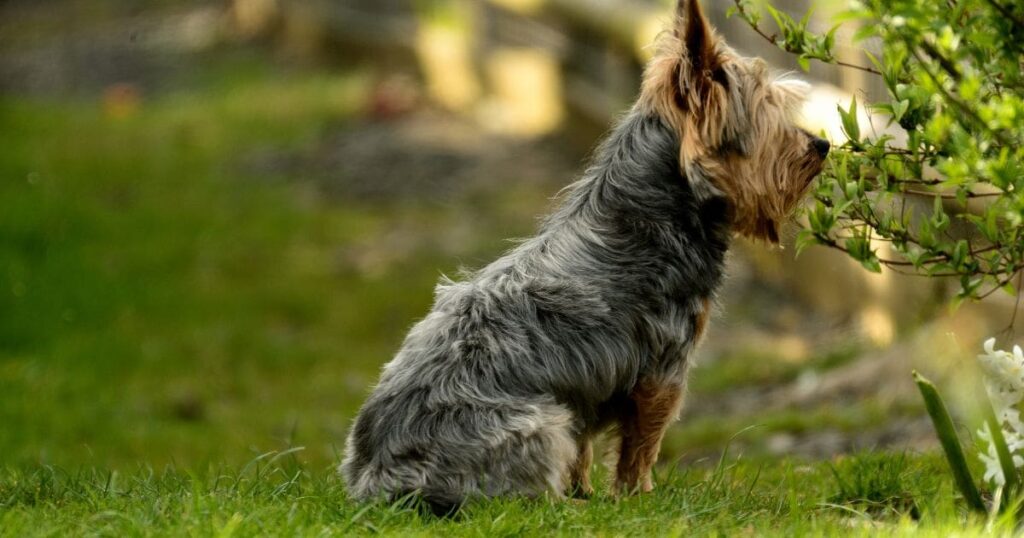
Perception in Dog Shows
The perception of tail docking in dog shows can vary among judges, breed enthusiasts, and the general public. Some judges and breeders may still have a preference for docked tails in Yorkies, considering it a traditional and characteristic feature of the breed. On the other hand, there is a growing awareness and acceptance of natural, undocked tails in the show ring.
As the AKC and other kennel clubs emphasize the importance of responsible breeding and the well-being of the dog, judges are encouraged to focus on the overall quality of the Yorkshire Terrier rather than placing undue emphasis on tail length.
The ultimate goal is to promote healthy and well-structured Yorkies that represent the breed’s true spirit.
The Natural Tail Vs. Docked Tail
When deciding whether to dock a Yorkshire Terrier’s tail, the controversy over natural versus docked tails is a crucial factor to take into account.
The Appeal of Natural Tails
Yorkies with natural tails exude a sense of authenticity and uniqueness. Their full-length, flowing tails are an integral part of their identity, reflecting the breed’s real nature.
A Yorkie’s tail aids communication, expressing different emotions & responses. It enhances self-expression by wagging happily or signaling curiosity. Pet owners bond with their Yorkie through the interaction with its natural tail, creating a strong connection.
Also, some studies show that undocked tails benefit balance & agility, enhancing overall strength.
The Attraction of Docked Tails
Docked tails have been the traditional choice for many Yorkie owners, primarily influenced by breed standards and historical practices.
In dog shows and competitions, docked tails have long been associated with the breed standard for Yorkshire Terriers, aligning with the ideal look for Yorkies in these events.
Additionally, some owners may choose to continue the tradition of tail docking to honor its historical significance, as it originated for practical purposes in the breed’s working past.
Moreover, for some individuals, the visual appeal and familiarity of a Yorkie with a docked tail contribute to their preference for this tail option.
The Docking Process
Tail docking is a surgical procedure performed on puppies within the first few days of their life. Every Yorkie owner should be aware of the process of tail docking for Yorkshire Terriers, the guidelines and methods used, and the ethical considerations surrounding this practice.
Docking Guidelines and Methods
Docking guidelines: The American Veterinary Medical Association (AVMA) provides guidelines on tail docking, recommending that the procedure be performed by a licensed veterinarian using appropriate anesthesia and surgical techniques. It is crucial to adhere to these guidelines to ensure the well-being of the puppy and to minimize discomfort.
Surgical procedure: The actual tail docking process involves removing a portion of the puppy’s tail using surgical scissors or a scalpel. The veterinarian will carefully remove the desired length of the tail, and the wound is typically closed with sutures or surgical adhesive.
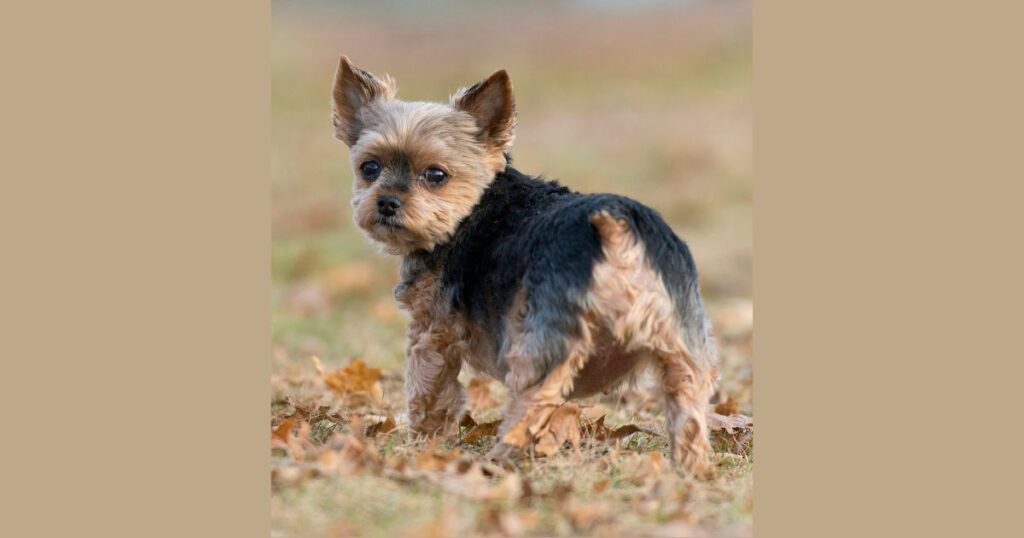
Making the Decision to tail-docking
The choice between a natural tail and a docked tail for Yorkshire Terriers is a complex decision that requires careful thought and consideration.
Choosing between a natural tail and a docked tail is a deeply personal decision for Yorkie owners. However, as responsible owners, ensuring the well-being of our beloved Yorkshire Terriers should always be a top priority.
When it comes to tail docking decisions, there are several important considerations to keep in mind.
- Breed Standards: If the intention is to participate in dog shows or competitions, owners should familiarize themselves with the breed standards set by kennel clubs, such as the AKC, to understand the tail requirements for Yorkies in the show ring.
- Lifestyle and Living Conditions: The living environment and lifestyle of the Yorkie should be considered. If the dog is an active and agile companion, a natural tail may be better suited to support its balance and mobility.
- Legal Regulations: As responsible owners, abiding by the laws and regulations regarding tail docking in your region is crucial. Some areas have specific rules regarding the procedure, and tail docking for cosmetic purposes may be prohibited. Complying with these regulations not only ensures the well-being of the puppy but also avoids potential legal consequences.
- Ethical Considerations: Reflect on the ethical implications of tail docking and weigh them against personal preferences and historical significance.
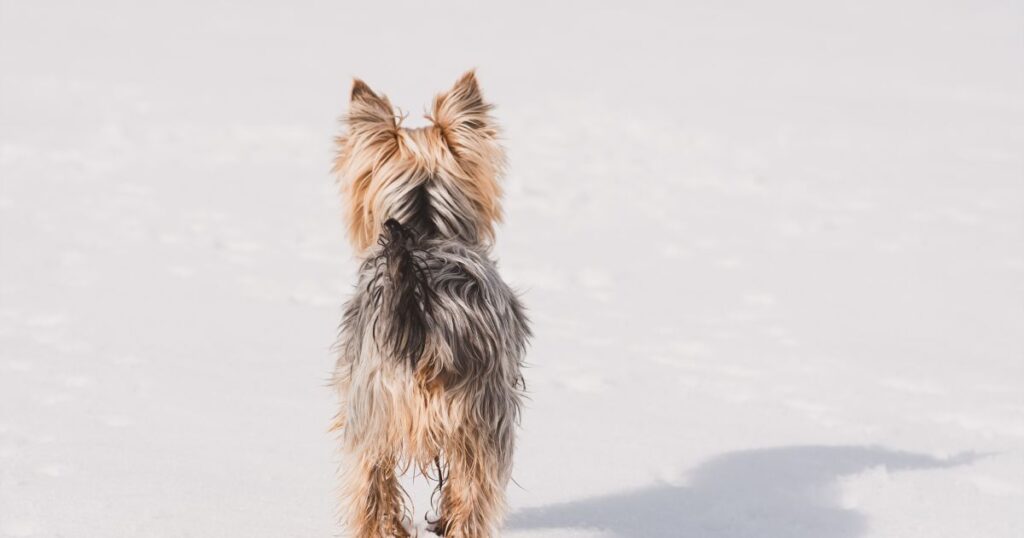
Exploring Tail Docking Alternatives
For those who prefer not to undergo tail docking, there are alternatives available to keep a Yorkie’s tail well-groomed and healthy. Regular tail grooming and proper hygiene practices can help maintain the cleanliness and appearance of the tail without the need for surgery.
Tail grooming techniques: Brushing and trimming the tail fur regularly can prevent matting and tangling, ensuring the tail remains in good condition.
Tail care: Keeping the tail clean and dry is crucial for the overall health and well-being of the dog. Regularly inspecting the tail for any signs of irritation or injury is recommended.
Tail accessories: If desired, decorative accessories such as bows or bands can be used to add a touch of style to the Yorkie’s tail without resorting to tail docking.
Whether an owner chooses to embrace the natural beauty of an undocked tail or adheres to the traditional aesthetics of a docked tail, the well-being and happiness of the Yorkie should always be the primary concern.
Considering alternatives to tail docking, adhering to legal regulations, and seeking expert advice are essential steps in providing our Yorkies with a happy and healthy life.
Tail Care and Happiness
This article delved into the world of Yorkshire Terrier tails, exploring the practice of tail docking, its historical significance, and the ethical debates surrounding it. We emphasized the importance of responsible ownership when it comes to tail docking decisions. Prioritizing the well-being of our beloved Yorkies should guide us in making informed choices.
Adhering to legal regulations and considering tail docking alternatives are essential steps in ensuring the happiness and comfort of our furry friends. Regular tail grooming and maintaining proper hygiene can contribute to a healthy and well-groomed tail without the need for surgery.
Keep in mind that a Yorkie’s tail is an important part of their communication and expression. We contribute to their general well-being and pleasure by keeping their tails healthy.
You can learn more about Yorkie tail docking if you have made the decision.
